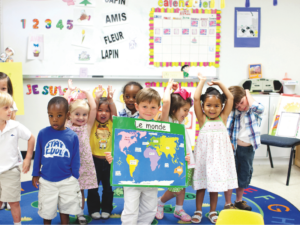Having knowledge of more than one language has become increasingly important in today’s world. Globalization has put people from a variety of linguistic backgrounds and cultures in contact more easily than ever before. Because of this, raising bilingual children is a rapidly growing trend among parents around the world.
Bilingualism allows children to communicate with more people in their community and internationally. It enables them to not only speak the language of another country or culture, but also to better understand and connect with a variety of cultures and the world around them.
Parents today are also aware that bilingualism can be an advantage in the job market, as more employers seek out individuals who can speak more than one language. Bilingualism also helps children’s learning because they can think about their ideas and solve problems in both languages.
Why early exposure to multiple languages?
Research shows that children up to age one hear every nuance of spoken languages. By age three, this ability begins to wane. By age seven, it has significantly decreased. Research further shows that after 10 or 12 years the brain handles language differently because until then it is constantly making neurological connections. As children we process language in the frontal lobe of the brain, but if we learn languages later as a teen or adult, the brain has to scramble to find storage space. Ultimately, the earlier a child can be exposed to multiple languages, the better.
How to raise a bilingual child.
For some families the decision to raise a bilingual child stems from the fact that one or both parents themselves speak a language other than English. In fact, approximately one-fifth of Americans speak a non-English language at home.
In families such as this, there is a variety of methods used to raise a bilingual child, with the most common being the parents deciding who will speak what language with careful attention to balancing the two languages. For example, one parent may speak exclusively Spanish, the other, English.
What about the parents who want to raise their child bilingual but neither parent is fluent in another language? According to the National Centre for Languages, almost four in ten parents intend to enroll their child in a bilingual school or afterschool program.
Local parents interested in a bilingual school environment need not look far. The only multi-lingual international school located between Atlanta and Houston is right here in Baton Rouge at the Baton Rouge International School (BRIS).
BRIS is a non-profit American school offering a rigorous college preparatory curriculum in a multilingual environment. BRIS opened its doors in 2000, initially as a pre-elementary school. Each year the school expanded and extended grade levels to meet the needs of its growing students. This fall, the school will go up to 11th grade, with the intention of having their first graduating class by the year 2013.
Beginning at six weeks old, children are offered a full immersion program in English, French, Spanish and Chinese. The curriculum is divided into five phases: Early Learning Immersion Curriculum, Pre-Elementary Curriculum, Middle School Curriculum and High School Curricula.
In order to facilitate early learning, children from ages six weeks to three years enter the Early Language Immersion Center. At this age, the children are taught only in French and Spanish. The goal is to create an environment similar to that of a traditional bilingual family, with each parent speaking a different language. In this case, the school has two teachers: one speaking only French, the other speaking only Spanish.
Co-founder Nathalie Guyon says that all foreign language teachers at BRIS are native speakers of the language they teach. Guyon contends that this is crucial to the process because from the moment you enter a particular classroom, the immersion in that language is further established by the “cultural feel of each teacher.”
The emphasis on French and Spanish continues until Kindergarten when the English curriculum is reintroduced. Chinese classes are optional beginning at age two, but required by the time the students get to middle school.
But with all this focus on languages, Guyon is quick to point out that it is the curriculum that makes the school unique. “It’s not just about the languages, the most important thing is the curriculum behind it, and we wouldn’t be able to do the curriculum we are doing without the languages….the curriculum we have established, we believe, is the best in the world,” said Guyon.
Guyon and co-founder Hafid Laroussi, as well as the entire faculty, are constantly evaluating and researching the “best practices” in education from all around the world in order to live up to these high standards.
The curriculum at BRIS goes beyond the requirements of the state curriculum. BRIS is also an IB World School accredited by the International Baccalaureate Organization. The upper levels of the school follow both IB and AP curricula since some colleges prefer one over the other.
For parents in the Baton Rouge community whose children do not attend BRIS but who are interested in exposing their child to language acquisition programs outside of the typical school day, there is a Foreign Language Summer Camp (Spanish, French and/or Chinese) open to any child in the Baton Rouge community.
Additionally, it is important for parents to remember: you don’t have to learn a language from birth or enroll your child in a bilingual school to experience the rewards that learning multiple languages can offer.






